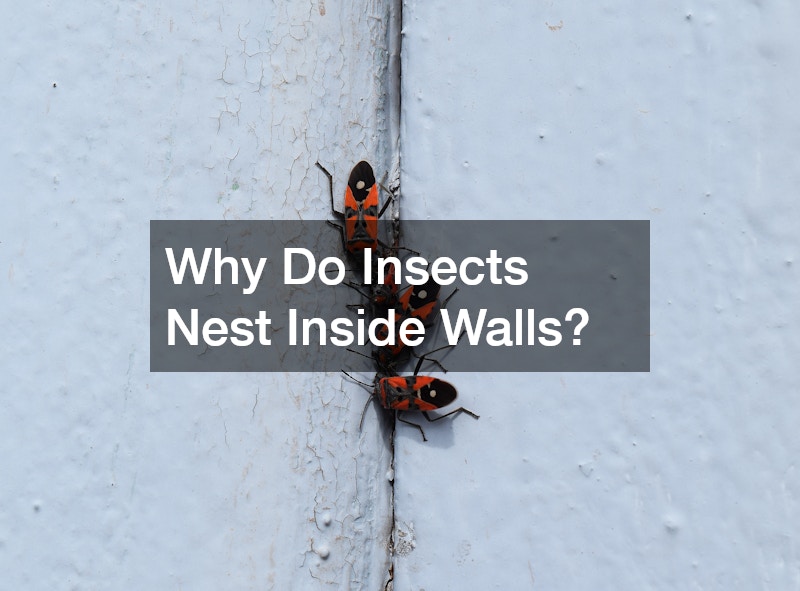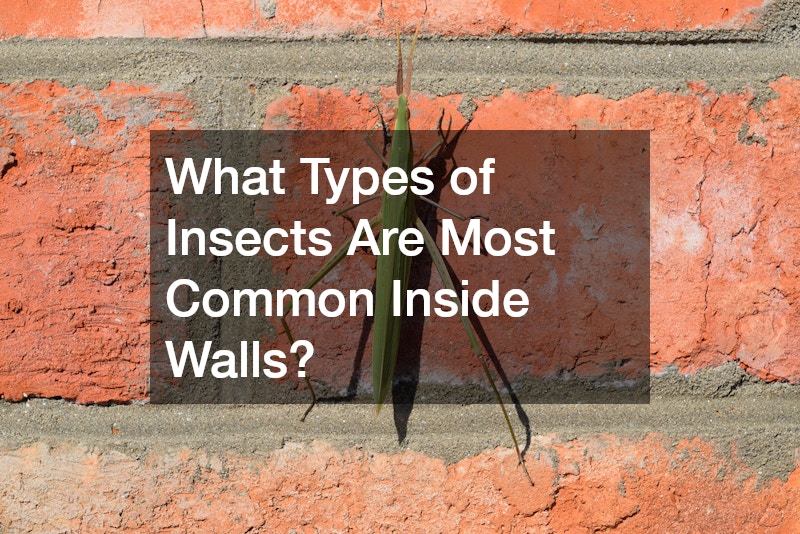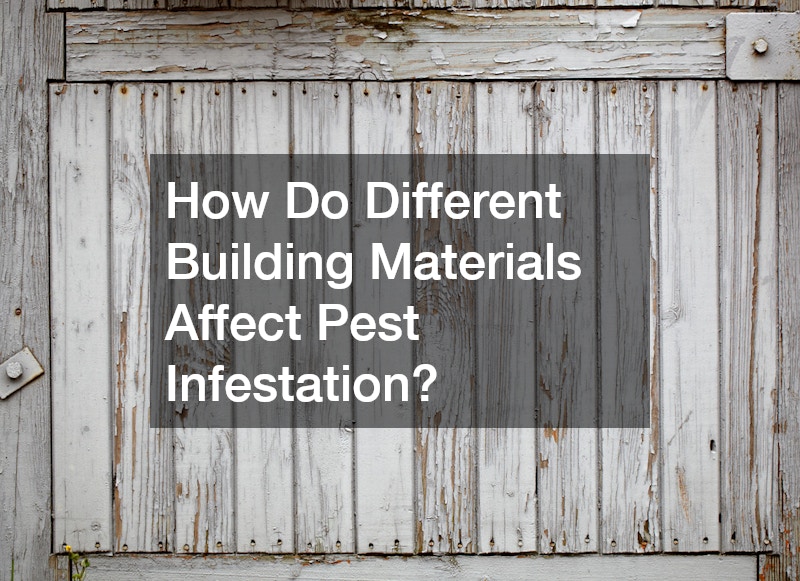Understanding the challenges of dealing with pests on your property and managing insects that have taken residence inside your walls is essential for maintaining a healthy, pest-free environment. These intruders can pose risks to your health, cause structural damage, and disrupt your comfort. Whether you’re dealing with the occasional ant or a hidden termite colony, knowing the reasons they invade, how to identify them, and what to do about them can save you significant time, money, and frustration.
In addition to common household insects, outdoor nuisances such as mosquitoes, ticks, skunks, and bats can also invade your space. Taking a comprehensive approach that includes tick control service, mosquito control, and reliable wildlife management can help safeguard your property. This article explores frequently asked questions and provides practical solutions for keeping your home and surroundings secure from pests of all kinds.
Why Do Insects Nest Inside Walls?

Poor Sealing and Gaps
One of the primary reasons insects find their way into wall cavities is due to inadequate sealing. Small cracks, holes around utility lines, poorly insulated windows, and gaps in siding serve as highways for insects seeking refuge. These vulnerable points are common issues identified by local pest control experts during inspections.
Environmental Factors
Temperature fluctuations, light availability, and seasonal changes play a big role in insect behavior. When external conditions become unfavorable—such as during extreme heat, cold, or rain—your walls offer a more stable and sheltered environment. Additionally, without proper rainwater management or stormwater management services, excess moisture can accumulate around your foundation, attracting pests like ants, cockroaches, and termites.
Access to Food Sources
Walls close to kitchens, pantries, or trash storage areas can attract insects due to the proximity of food. Even a few crumbs behind the stove or inside the wall voids can be enough to sustain a population of ants or cockroaches. Local pest control professionals often recommend good sanitation practices to minimize these attractants.
Moisture and Humidity Levels
Moisture attracts many pest species. Leaking pipes, poorly ventilated bathrooms, or high indoor humidity levels can make wall cavities the ideal nesting spots for insects such as termites, silverfish, and cockroaches. These conditions may also indicate a more serious problem, such as a hidden leak that could require water leak leak detection or water damage restoration services to fully resolve.
Attractive Sheltering Conditions
Darkness, still air, and insulation materials create an appealing environment for insects. Walls are generally undisturbed and provide excellent protection from predators. Insects like spiders and moths can go undetected for months in these hidden recesses, reproducing and expanding their colonies silently.
How Can I Identify Insects Inside My Walls?
Signs of Activity
Even if insects are out of sight, they often leave signs behind. Common indicators include droppings, shed skins, small holes in walls or baseboards, and insect wings. Ant trails, grease marks, or unusual smells may also suggest the presence of pests within the walls. Animals like skunks will be easy to identify by their odor. If you have problems with skunks, contact skunk removal companies, it’s not worth getting sprayed.
Audible Indications
Some insects are noisy, especially at night when the home is quiet. Clicking, tapping, or rustling sounds may be heard if termites, carpenter ants, or beetles are active inside wooden walls. If these sounds are accompanied by signs of water intrusion, it’s wise to consider both termite control and water damage restoration, as the two often go hand in hand. removal companies
Visual Examination
Careful visual inspection around baseboards, vents, electrical outlets, and plumbing fixtures can reveal entry points or insect activity. Discoloration, bubbling paint, or sagging walls may point to moisture damage from pest activity, particularly in the case of termites.
Professional Inspection Techniques
Pest control professionals utilize advanced tools to locate insects hidden inside walls. These include moisture meters, thermal imaging cameras, and acoustic detection devices. These tools are often used in conjunction with water leak detection services to determine if pest infestations are the result of underlying moisture issues.
Using Technological Aids
Smart home devices, such as motion sensors and wireless cameras, can detect irregular activity or movement within wall cavities. Boroscopes—small cameras on flexible tubes—can be inserted into small openings to visually inspect the interior of walls for nests or burrows.
What Types of Insects Are Most Common Inside Walls?

Termites
Termites are notorious for infesting wall interiors, especially in wooden frame homes. They silently eat away at structural wood, often going unnoticed until major damage is done. Their presence is often identified by mud tubes, discarded wings, or hollow-sounding wood. Effective termite control typically involves a combination of bait systems, soil treatments, and moisture mitigation.
Ants
Ants are highly adaptable and often nest inside walls, especially near kitchens or bathrooms. Carpenter ants, in particular, burrow into damp or rotting wood, compromising structural integrity while remaining hidden. Local pest control specialists can help identify ant species and apply targeted treatments.
Beetles
Certain beetle species, like powderpost beetles, bore into wood and lay their eggs. The larvae hatch and eat through the wood, eventually emerging through tiny exit holes. Their presence is usually identified by fine wood dust, also called frass.
Spiders
Spiders may not nest inside the walls themselves but often crawl into wall voids in search of shelter and prey. They’re frequently found near baseboards, vents, and ceiling corners, using the quiet of the walls to spin their webs undisturbed.
Moths
Pantry moths and clothes moths may establish themselves in wall cavities near food storage or closets. While their larvae cause the most damage, the adults can flutter into open spaces, tipping off homeowners to an infestation.
How Do I Prevent Insects from Entering My Walls?
Sealing Entry Points
Carefully inspect your home’s exterior and interior for cracks, gaps, and other entry points. Use silicone caulk or expandable foam to seal these openings. Effective rainwater management can also help by preventing moisture buildup around the home’s foundation that attracts insects.
Regular Maintenance Practices
Routine maintenance goes a long way in preventing pests. Replace damaged weatherstripping, repair broken screens, and fix leaking pipes or faucets. If you notice staining or musty odors, it may indicate a deeper problem requiring water damage restoration or even a call for water leak detection services.
Yard and Landscaping Management
Insects often originate outdoors before finding their way inside. Keep vegetation trimmed away from your home, remove mulch buildup near the foundation, and store firewood away from the structure. For added protection, mosquito control and tick control service are especially helpful in managing yard-borne threats.
Humidity Control
Use dehumidifiers and ensure proper ventilation in attics, crawlspaces, and basements. Address water leaks and improve drainage around your property to minimize moisture buildup, which attracts pests like termites and silverfish.
Routine Inspections
Conduct seasonal inspections of your home, particularly in vulnerable areas. Look for signs of insect activity and damage. Enlist a local pest control provider to carry out a thorough evaluation and recommend appropriate preventative steps.
What Are the DIY Methods to Remove Insects from Walls?
Natural Repellents
Essential oils like peppermint, tea tree, and eucalyptus can deter insects. These can be mixed with water and sprayed around baseboards, vents, and cracks to create a natural barrier that discourages entry and nesting.
Traps and Baits
Sticky traps, bait stations, and pheromone traps can lure insects out of their hiding places. These are especially effective for ants, roaches, and moths. Positioning them near access points maximizes their effectiveness.
Using Vacuum Cleaners
For active infestations near surface areas, a vacuum with a hose attachment can be a quick way to remove insects. This method is particularly helpful for visible spiders, ants, and beetles and reduces their numbers significantly when done consistently.
Essential Oils Application
Dabbing cotton balls in essential oils and placing them near wall openings can help deter insects from nesting. Clove oil and cedarwood oil are particularly effective against moths and beetles.
DIY Spray Solutions
Homemade sprays using ingredients like vinegar, baking soda, lemon juice, or dish soap can be effective against certain pests. These mixtures are generally safe for indoor use and can be sprayed into cracks and crevices to disrupt insect activity.
When Should I Call a Professional Exterminator?

Persistent Infestation
If insects keep returning despite your best DIY efforts, it’s time to bring in the experts. Persistent infestations usually indicate a deeper problem that requires specialized tools and knowledge to resolve.
Large Scale Problems
Widespread infestations, especially those that affect multiple rooms or large sections of wall space, are best handled professionally. Larger populations can rapidly multiply and cause extensive damage if left unchecked.
Health and Safety Concerns
Certain pests pose serious health risks. For example, ticks can transmit Lyme disease, while mosquitoes carry viruses like West Nile. Enlisting mosquito control and tick control service helps mitigate these dangers in high-risk areas.
Structural Damage
Evidence of structural damage, such as crumbling drywall, sagging floors, or compromised wood framing, should never be ignored. Professionals can assess the extent of the damage and coordinate repairs along with eradication efforts.
Lack of Results from DIY Methods
When homemade solutions and store-bought products fail to provide lasting results, professionals bring a more comprehensive approach. They can identify entry points, use commercial-grade products, and provide follow-up services to ensure success.
Are Chemical Solutions Effective for Insects in Walls?
Types of Chemical Treatments
Various chemical treatments exist for managing wall-dwelling pests. These include insecticidal sprays, dusts, and foams that can be applied into wall cavities. Some are slow-acting to allow insects to carry the poison back to the nest.
Effectiveness vs. Safety
While effective, chemical treatments must be handled carefully. Products labeled for indoor use are generally safer for enclosed spaces. Professional termite control services often use industry-grade chemicals that are effective while minimizing risk to household members.
Application Methods
Application techniques depend on the product type. Some are sprayed directly into wall voids, while others require drilling small holes for targeted application. Professionals may use pressurized equipment for deep penetration into infested walls.
Potential Risks Involved
Improper use of chemical treatments can lead to respiratory issues, skin irritation, or chemical burns. Overuse can also lead to resistance in some insect populations, making future infestations harder to manage.
Eco-Friendly Alternatives
For those seeking less toxic solutions, eco-friendly options include diatomaceous earth, boric acid, and plant-based sprays. These alternatives are often preferred for families with pets and children.
How Can I Deal with Pests in Hard-to-Reach Wall Areas?
Specialized Tools Utilization
Tools such as compressed air dusters, long-reach sprayers, and injector wands can help you access narrow spaces within walls. These tools deliver treatment where your hands or conventional sprayers can’t reach.
Access through Wall Openings
Sometimes it’s necessary to open small sections of drywall to reach infestations directly. This should be done cautiously to avoid damaging electrical wiring or plumbing. Small access panels can later be patched or concealed.
Remote Monitoring Devices
Battery-operated or Wi-Fi-enabled sensors can be placed inside walls to monitor insect movement and temperature changes. These devices are ideal for long-term management and early detection of returning pests.
Boroscope Inspections
A boroscope is a slender camera that can be inserted through a small drilled hole to visually inspect hidden areas. This tool is widely used by pest control professionals and allows accurate diagnosis before treatment.
Pro Technician Assistance
When all else fails, professional technicians have the experience and equipment necessary to handle difficult infestations. Some companies also offer bat removal and skunk removal services in addition to insect extermination—making them a one-stop solution for both small and large invaders.
What Is the Role of the Seasons in Pest Behavior?
Winter Inactivity
During colder months, many insects become dormant or seek warmer indoor environments. You may notice an uptick in activity as pests move deeper into the walls to escape the cold. Insulating your home properly and managing external moisture with stormwater management services can reduce winter invasions.
Spring Awakening
Spring signals a rebirth for insect populations. As temperatures rise, many dormant pests become active and begin reproducing. Early detection and intervention in spring can help curb larger summer infestations.
Summer Proliferation
Summer is prime time for insect activity. Increased heat and humidity accelerate reproduction rates and colony expansion. Outdoor pests like mosquitoes and ticks also flourish, making mosquito control and tick control service vital during these months.
Autumn Prevention Strategies
Insects begin seeking winter shelter in the fall, making this the ideal season for sealing entry points, performing inspections, and applying preventative treatments. Taking action in autumn reduces the likelihood of winter nesting.
Seasonal Inspection Guidelines
Each season presents unique risks, so seasonal inspections should focus on vulnerable areas. Winter requires checks for hidden nesting, spring for emerging pests, summer for active colonies, and fall for prevention strategies.
How Do Different Building Materials Affect Pest Infestation?

Wood Frame Structures
Wood is highly vulnerable to pests such as termites and carpenter ants. If untreated or exposed to moisture, it becomes an easy target for nesting and feeding. Water intrusion in these structures often necessitates water damage restoration and termite control in tandem.
Brick and Mortar
Brick homes are more pest-resistant but not immune. Cracks in mortar or gaps between bricks can become entry points for ants, spiders, and other small insects. Proper stormwater management around the foundation helps reduce moisture buildup in these gaps.
Siding Types and Their Impact
Wood siding, while attractive, is highly susceptible to insect infestation. Vinyl siding can hide moisture damage and entry points if not installed properly. Fiber cement and aluminum are more pest-resistant but still require maintenance to remain effective.
Concrete Walls
Concrete walls offer fewer nesting opportunities for insects but are not entirely pest-proof. Gaps around plumbing and electrical conduits can still serve as access points. Moisture accumulation can lead to mold, which attracts certain insects.
Innovative Materials and Technologies
New building materials incorporate pest-resistant features, such as treated lumber and composite siding. Innovations like smart insulation and insect-repellent coatings help reduce the likelihood of infestation and make maintenance easier.
Conclusion
Effectively managing pests on your property and the insects residing within your walls requires a comprehensive understanding of their habits and access points. By combining preventive strategies, seasonal awareness, rainwater and stormwater management, and the assistance of professionals offering services such as termite control, bat removal, skunk removal, and water leak detection, you can maintain a safe, pest-free environment. Regular maintenance, eco-conscious solutions, and trusted local pest control support are essential in protecting both your health and your home’s integrity year-round.
Understanding the challenges of dealing with pests on your property and managing insects that have taken residence inside your walls is essential for maintaining a healthy, pest-free environment. These intruders can pose risks to your health, cause structural damage, and disrupt your comfort. Whether you’re dealing with the occasional ant or a hidden termite colony, knowing the reasons they invade, how to identify them, and what to do about them can save you significant time, money, and frustration.
In addition to common household insects, outdoor nuisances such as mosquitoes, ticks, skunks, and bats can also invade your space. Taking a comprehensive approach that includes tick control service, mosquito control, and reliable wildlife management can help safeguard your property. This article explores frequently asked questions and provides practical solutions for keeping your home and surroundings secure from pests of all kinds.
Why Do Insects Nest Inside Walls?
Poor Sealing and Gaps
One of the primary reasons insects find their way into wall cavities is due to inadequate sealing. Small cracks, holes around utility lines, poorly insulated windows, and gaps in siding serve as highways for insects seeking refuge. These vulnerable points are common issues identified by local pest control experts during inspections.
Environmental Factors
Temperature fluctuations, light availability, and seasonal changes play a big role in insect behavior. When external conditions become unfavorable—such as during extreme heat, cold, or rain—your walls offer a more stable and sheltered environment. Additionally, without proper rainwater management or stormwater management services, excess moisture can accumulate around your foundation, attracting pests like ants, cockroaches, and termites.
Access to Food Sources
Walls close to kitchens, pantries, or trash storage areas can attract insects due to the proximity of food. Even a few crumbs behind the stove or inside the wall voids can be enough to sustain a population of ants or cockroaches. Local pest control professionals often recommend good sanitation practices to minimize these attractants.
Moisture and Humidity Levels
Moisture attracts many pest species. Leaking pipes, poorly ventilated bathrooms, or high indoor humidity levels can make wall cavities the ideal nesting spots for insects such as termites, silverfish, and cockroaches. These conditions may also indicate a more serious problem, such as a hidden leak that could require water leak leak detection or water damage restoration services to fully resolve.
Attractive Sheltering Conditions
Darkness, still air, and insulation materials create an appealing environment for insects. Walls are generally undisturbed and provide excellent protection from predators. Insects like spiders and moths can go undetected for months in these hidden recesses, reproducing and expanding their colonies silently.
How Can I Identify Insects Inside My Walls?
Signs of Activity
Even if insects are out of sight, they often leave signs behind. Common indicators include droppings, shed skins, small holes in walls or baseboards, and insect wings. Ant trails, grease marks, or unusual smells may also suggest the presence of pests within the walls. Animals like skunks will be easy to identify by their odor. If you have problems with skunks, contact skunk removal companies, it’s not worth getting sprayed.
Audible Indications
Some insects are noisy, especially at night when the home is quiet. Clicking, tapping, or rustling sounds may be heard if termites, carpenter ants, or beetles are active inside wooden walls. If these sounds are accompanied by signs of water intrusion, it’s wise to consider both termite control and water damage restoration, as the two often go hand in hand. removal companies
Visual Examination
Careful visual inspection around baseboards, vents, electrical outlets, and plumbing fixtures can reveal entry points or insect activity. Discoloration, bubbling paint, or sagging walls may point to moisture damage from pest activity, particularly in the case of termites.
Professional Inspection Techniques
Pest control professionals utilize advanced tools to locate insects hidden inside walls. These include moisture meters, thermal imaging cameras, and acoustic detection devices. These tools are often used in conjunction with water leak detection services to determine if pest infestations are the result of underlying moisture issues.
Using Technological Aids
Smart home devices, such as motion sensors and wireless cameras, can detect irregular activity or movement within wall cavities. Boroscopes—small cameras on flexible tubes—can be inserted into small openings to visually inspect the interior of walls for nests or burrows.
What Types of Insects Are Most Common Inside Walls?
Termites
Termites are notorious for infesting wall interiors, especially in wooden frame homes. They silently eat away at structural wood, often going unnoticed until major damage is done. Their presence is often identified by mud tubes, discarded wings, or hollow-sounding wood. Effective termite control typically involves a combination of bait systems, soil treatments, and moisture mitigation.
Ants
Ants are highly adaptable and often nest inside walls, especially near kitchens or bathrooms. Carpenter ants, in particular, burrow into damp or rotting wood, compromising structural integrity while remaining hidden. Local pest control specialists can help identify ant species and apply targeted treatments.
Beetles
Certain beetle species, like powderpost beetles, bore into wood and lay their eggs. The larvae hatch and eat through the wood, eventually emerging through tiny exit holes. Their presence is usually identified by fine wood dust, also called frass.
Spiders
Spiders may not nest inside the walls themselves but often crawl into wall voids in search of shelter and prey. They’re frequently found near baseboards, vents, and ceiling corners, using the quiet of the walls to spin their webs undisturbed.
Moths
Pantry moths and clothes moths may establish themselves in wall cavities near food storage or closets. While their larvae cause the most damage, the adults can flutter into open spaces, tipping off homeowners to an infestation.
How Do I Prevent Insects from Entering My Walls?
Sealing Entry Points
Carefully inspect your home’s exterior and interior for cracks, gaps, and other entry points. Use silicone caulk or expandable foam to seal these openings. Effective rainwater management can also help by preventing moisture buildup around the home’s foundation that attracts insects.
Regular Maintenance Practices
Routine maintenance goes a long way in preventing pests. Replace damaged weatherstripping, repair broken screens, and fix leaking pipes or faucets. If you notice staining or musty odors, it may indicate a deeper problem requiring water damage restoration or even a call for water leak detection services.
Yard and Landscaping Management
Insects often originate outdoors before finding their way inside. Keep vegetation trimmed away from your home, remove mulch buildup near the foundation, and store firewood away from the structure. For added protection, mosquito control and tick control services are especially helpful in managing yard-borne threats.
Humidity Control
Use dehumidifiers and ensure proper ventilation in attics, crawlspaces, and basements. Address water leaks and improve drainage around your property to minimize moisture buildup, which attracts pests like termites and silverfish.
Routine Inspections
Conduct seasonal inspections of your home, particularly in vulnerable areas. Look for signs of insect activity and damage. Enlist a local pest control provider to carry out a thorough evaluation and recommend appropriate preventative steps.
What Are the DIY Methods to Remove Insects from Walls?
Natural Repellents
Essential oils like peppermint, tea tree, and eucalyptus can deter insects. These can be mixed with water and sprayed around baseboards, vents, and cracks to create a natural barrier that discourages entry and nesting.
Traps and Baits
Sticky traps, bait stations, and pheromone traps can lure insects out of their hiding places. These are especially effective for ants, roaches, and moths. Positioning them near access points maximizes their effectiveness.
Using Vacuum Cleaners
For active infestations near surface areas, a vacuum with a hose attachment can be a quick way to remove insects. This method is particularly helpful for visible spiders, ants, and beetles and reduces their numbers significantly when done consistently.
Essential Oils Application
Dabbing cotton balls in essential oils and placing them near wall openings can help deter insects from nesting. Clove oil and cedarwood oil are particularly effective against moths and beetles.
DIY Spray Solutions
Homemade sprays using ingredients like vinegar, baking soda, lemon juice, or dish soap can be effective against certain pests. These mixtures are generally safe for indoor use and can be sprayed into cracks and crevices to disrupt insect activity.
When Should I Call a Professional Exterminator?
Persistent Infestation
If insects keep returning despite your best DIY efforts, it’s time to bring in the experts. Persistent infestations usually indicate a deeper problem that requires specialized tools and knowledge to resolve.
Large Scale Problems
Widespread infestations, especially those that affect multiple rooms or large sections of wall space, are best handled professionally. Larger populations can rapidly multiply and cause extensive damage if left unchecked.
Health and Safety Concerns
Certain pests pose serious health risks. For example, ticks can transmit Lyme disease, while mosquitoes carry viruses like West Nile. Enlisting mosquito control and tick control service helps mitigate these dangers in high-risk areas.
Structural Damage
Evidence of structural damage, such as crumbling drywall, sagging floors, or compromised wood framing, should never be ignored. Professionals can assess the extent of the damage and coordinate repairs along with eradication efforts.
Lack of Results from DIY Methods
When homemade solutions and store-bought products fail to provide lasting results, professionals bring a more comprehensive approach. They can identify entry points, use commercial-grade products, and provide follow-up services to ensure success.
Are Chemical Solutions Effective for Insects in Walls?
Types of Chemical Treatments
Various chemical treatments exist for managing wall-dwelling pests. These include insecticidal sprays, dusts, and foams that can be applied into wall cavities. Some are slow-acting to allow insects to carry the poison back to the nest.
Effectiveness vs. Safety
While effective, chemical treatments must be handled carefully. Products labeled for indoor use are generally safer for enclosed spaces. Professional termite control services often use industry-grade chemicals that are effective while minimizing risk to household members.
Application Methods
Application techniques depend on the product type. Some are sprayed directly into wall voids, while others require drilling small holes for targeted application. Professionals may use pressurized equipment for deep penetration into infested walls.
Potential Risks Involved
Improper use of chemical treatments can lead to respiratory issues, skin irritation, or chemical burns. Overuse can also lead to resistance in some insect populations, making future infestations harder to manage.
Eco-Friendly Alternatives
For those seeking less toxic solutions, eco-friendly options include diatomaceous earth, boric acid, and plant-based sprays. These alternatives are often preferred for families with pets and children.
How Can I Deal with Pests in Hard-to-Reach Wall Areas?
Specialized Tools Utilization
Tools such as compressed air dusters, long-reach sprayers, and injector wands can help you access narrow spaces within walls. These tools deliver treatment where your hands or conventional sprayers can’t reach.
Access through Wall Openings
Sometimes it’s necessary to open small sections of drywall to reach infestations directly. This should be done cautiously to avoid damaging electrical wiring or plumbing. Small access panels can later be patched or concealed.
Remote Monitoring Devices
Battery-operated or Wi-Fi-enabled sensors can be placed inside walls to monitor insect movement and temperature changes. These devices are ideal for long-term management and early detection of returning pests.
Boroscope Inspections
A boroscope is a slender camera that can be inserted through a small drilled hole to visually inspect hidden areas. This tool is widely used by pest control professionals and allows accurate diagnosis before treatment.
Pro Technician Assistance
When all else fails, professional technicians have the experience and equipment necessary to handle difficult infestations. Some companies also offer bat removal and skunk removal services in addition to insect extermination—making them a one-stop solution for both small and large invaders.
What Is the Role of the Seasons in Pest Behavior?
Winter Inactivity
During colder months, many insects become dormant or seek warmer indoor environments. You may notice an uptick in activity as pests move deeper into the walls to escape the cold. Insulating your home properly and managing external moisture with stormwater management services can reduce winter invasions.
Spring Awakening
Spring signals a rebirth for insect populations. As temperatures rise, many dormant pests become active and begin reproducing. Early detection and intervention in spring can help curb larger summer infestations.
Summer Proliferation
Summer is prime time for insect activity. Increased heat and humidity accelerate reproduction rates and colony expansion. Outdoor pests like mosquitoes and ticks also flourish, making mosquito control and tick control service vital during these months.
Autumn Prevention Strategies
Insects begin seeking winter shelter in the fall, making this the ideal season for sealing entry points, performing inspections, and applying preventative treatments. Taking action in autumn reduces the likelihood of winter nesting.
Seasonal Inspection Guidelines
Each season presents unique risks, so seasonal inspections should focus on vulnerable areas. Winter requires checks for hidden nesting, spring for emerging pests, summer for active colonies, and fall for prevention strategies.
How Do Different Building Materials Affect Pest Infestation?
Wood Frame Structures
Wood is highly vulnerable to pests such as termites and carpenter ants. If untreated or exposed to moisture, it becomes an easy target for nesting and feeding. Water intrusion in these structures often necessitates water damage restoration and termite control in tandem.
Brick and Mortar
Brick homes are more pest-resistant but not immune. Cracks in mortar or gaps between bricks can become entry points for ants, spiders, and other small insects. Proper stormwater management around the foundation helps reduce moisture buildup in these gaps.
Siding Types and Their Impact
Wood siding, while attractive, is highly susceptible to insect infestation. Vinyl siding can hide moisture damage and entry points if not installed properly. Fiber cement and aluminum are more pest-resistant but still require maintenance to remain effective.
Concrete Walls
Concrete walls offer fewer nesting opportunities for insects but are not entirely pest-proof. Gaps around plumbing and electrical conduits can still serve as access points. Moisture accumulation can lead to mold, which attracts certain insects.
Innovative Materials and Technologies
New building materials incorporate pest-resistant features, such as treated lumber and composite siding. Innovations like smart insulation and insect-repellent coatings help reduce the likelihood of infestation and make maintenance easier.
Conclusion
Effectively managing pests on your property and the insects residing within your walls requires a comprehensive understanding of their habits and access points. By combining preventive strategies, seasonal awareness, rainwater and stormwater management, and the assistance of professionals offering services such as termite control, bat removal, skunk removal, and water leak detection, you can maintain a safe, pest-free environment. Regular maintenance, eco-conscious solutions, and trusted local pest control support are essential in protecting both your health and your home’s integrity year-round.



